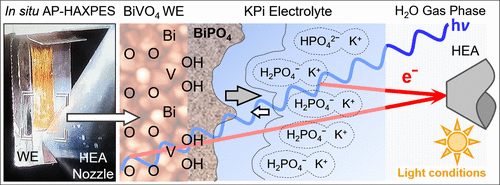当前位置:
X-MOL 学术
›
J. Phys. Chem. B
›
论文详情
Our official English website, www.x-mol.net, welcomes your
feedback! (Note: you will need to create a separate account there.)
Light-Induced Surface Reactions at the Bismuth Vanadate/Potassium Phosphate Interface
The Journal of Physical Chemistry B ( IF 2.8 ) Pub Date : 2017-09-18 00:00:00 , DOI: 10.1021/acs.jpcb.7b06942 Marco Favaro 1 , Fatwa F. Abdi 1 , Marlene Lamers 1 , Ethan J. Crumlin 2 , Zhi Liu 3, 4 , Roel van de Krol 1 , David E. Starr 1
The Journal of Physical Chemistry B ( IF 2.8 ) Pub Date : 2017-09-18 00:00:00 , DOI: 10.1021/acs.jpcb.7b06942 Marco Favaro 1 , Fatwa F. Abdi 1 , Marlene Lamers 1 , Ethan J. Crumlin 2 , Zhi Liu 3, 4 , Roel van de Krol 1 , David E. Starr 1
Affiliation

|
Bismuth vanadate has recently drawn significant research attention as a light-absorbing photoanode due to its performance for photoelectrochemical water splitting. In this study, we use in situ ambient pressure X-ray photoelectron spectroscopy with “tender” X-rays (4.0 keV) to investigate a polycrystalline bismuth vanadate (BiVO4) electrode in contact with an aqueous potassium phosphate (KPi) solution at open circuit potential under both dark and light conditions. This is facilitated by the creation of a 25 to 30 nm thick electrolyte layer using the “dip-and-pull” method. We observe that under illumination bismuth phosphate forms on the BiVO4 surface leading to an increase of the surface negative charge. The bismuth phosphate layer may act to passivate surface states observed in photoelectrochemical measurements. The repulsive interaction between the negatively charged surface under illumination and the phosphate ions in solution causes a shift in the distribution of ions in the thin aqueous electrolyte film, which is observed as an increase in their photoelectron signals. Interestingly, we find that such changes at the BiVO4/KPi electrolyte interface are reversible upon returning to dark conditions. By measuring the oxygen 1s photoelectron peak intensities from the phosphate ions and liquid water as a function of time under dark and light conditions, we determine the time scales for the forward and reverse reactions. Our results provide direct evidence for light-induced chemical modification of the BiVO4/KPi electrolyte interface.
中文翻译:

钒酸铋/磷酸钾界面的光诱导表面反应
钒酸铋由于其光电化学水分解性能而作为吸光光阳极最近引起了广泛的研究关注。在这项研究中,我们使用原位环境压力X射线光电子能谱和“嫩” X射线(4.0 keV)来研究多晶钒酸铋(BiVO 4)电极在开放时与磷酸钾(KPi)水溶液接触的情况。在黑暗和明亮条件下的电路电位。通过使用“浸入-拉出”方法创建25至30 nm厚的电解质层,可以简化这一过程。我们观察到在光照下BiVO 4上会形成磷酸铋。表面导致表面负电荷的增加。磷酸铋层可以起到钝化在光电化学测量中观察到的表面状态的作用。在照明下带负电的表面与溶液中的磷酸根离子之间的排斥相互作用导致薄水电解质膜中离子的分布发生变化,这被视为其光电子信号的增加。有趣的是,我们发现BiVO 4的这种变化/ KPi电解质界面在恢复到黑暗条件后可逆。通过在黑暗和明亮的条件下测量磷酸盐离子和液态水的氧1s光电子峰强度随时间的变化,我们确定了正向和反向反应的时间尺度。我们的结果为BiVO 4 / KPi电解质界面的光诱导化学修饰提供了直接的证据。
更新日期:2017-09-18
中文翻译:

钒酸铋/磷酸钾界面的光诱导表面反应
钒酸铋由于其光电化学水分解性能而作为吸光光阳极最近引起了广泛的研究关注。在这项研究中,我们使用原位环境压力X射线光电子能谱和“嫩” X射线(4.0 keV)来研究多晶钒酸铋(BiVO 4)电极在开放时与磷酸钾(KPi)水溶液接触的情况。在黑暗和明亮条件下的电路电位。通过使用“浸入-拉出”方法创建25至30 nm厚的电解质层,可以简化这一过程。我们观察到在光照下BiVO 4上会形成磷酸铋。表面导致表面负电荷的增加。磷酸铋层可以起到钝化在光电化学测量中观察到的表面状态的作用。在照明下带负电的表面与溶液中的磷酸根离子之间的排斥相互作用导致薄水电解质膜中离子的分布发生变化,这被视为其光电子信号的增加。有趣的是,我们发现BiVO 4的这种变化/ KPi电解质界面在恢复到黑暗条件后可逆。通过在黑暗和明亮的条件下测量磷酸盐离子和液态水的氧1s光电子峰强度随时间的变化,我们确定了正向和反向反应的时间尺度。我们的结果为BiVO 4 / KPi电解质界面的光诱导化学修饰提供了直接的证据。











































 京公网安备 11010802027423号
京公网安备 11010802027423号